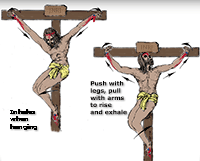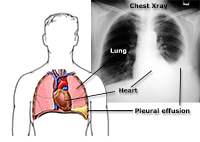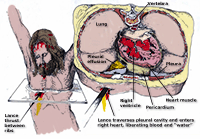Jesus' Death by Crucifixion
That Jesus of Nazareth died on the cross cannot be plausibly denied. Notwithstanding this, some who are motivated by a need to deny the resurrection of Christ, fashioned a so-called "swoon theory" to attempt to explain away the post-crucifixion appearances of Jesus. According to this theory, Jesus didn’t really die at His crucifixion, but was merely unconscious when He was laid in the tomb (and there He resuscitated). As there is only one case known to history in which a person was removed from a Roman cross and survived, (following a long period of devoted medical attention), and given our modern understanding of the medical issues around crucifixion, we can be confident that Jesus did in fact expire on the cross. Additionally, three critically important witnesses at the time attested to his death, (the Roman guards, Pilate, and the Sanhedrin).
How Did Jesus Die?
We cannot be certain of what process ultimately took the life of Jesus, but a reconstruction of the events, together with a knowledge of human physiology and medicine can lead us to some reasonable hypotheses. Contributing factors include many events that preceded the actual cross experience.
On the evening of the night before his death, Jesus stayed in the Garden of Gethsemane with his disciples. There, we are told that he went through terrible anguish as he looked forward to his upcoming trial. His stress was so severe that Jesus sweat drops of blood. A rare medical condition called hematohidrosis causes capillary blood vessels that feed the sweat glands to break down releasing blood from the vessels into the glands, causing the body to sweat drops of blood. This condition results from mental anguish and has been most often observed in individuals awaiting execution on death row. Jesus expressed his distress by saying "my soul is deeply grieved to the point of death" (Matthew 26:38). Because hematohidrosis makes the skin tender, it would have made the injuries that would follow all the more horrible.
Matthew 26:36-46, Mark 14:37-42, Luke 22:39-44
During the night, Jesus was taken from Gethsemane to Jerusalem and made to walk for miles between the houses of Annas, Caiaphas, the Praetorium (or Antonia Fortress) and the palace of Herod Antipas. He was beaten and held over night without food or water.
Matthew 26:67-75, Mark 14:61-72, Luke 22:54-23:25, John 18:16-27
The next morning, Pilate ordered Jesus to be scourged. The flogging left the skin on Jesus’ back in long ribbons. By this point, he had lost a significant volume of blood, causing his blood pressure to fall and moving him toward hypovolemic shock. (The human body attempts to remedy imbalances such as decreased blood volume by a variety of mechanisms, including diminished urine production and increased thirst.)
Roman soldiers placed a crown of thorns on Jesus’ head (probably zizyphus spina) and a robe on his back. The robe helped the blood to clot temporarily. As the scalp is an extremely vascular tissue, the thorns from the crown pushed into the skin and he began bleeding profusely. Soon thereafter, they ripped the robe off Jesus’ back and the bleeding from his scourging started afresh. Due to severe blood loss without replacement, Jesus was likely going into shock, and as a result, was unable to carry the cross without the aid of Simon of Cyrene.
Matthew 27:28-29, Matthew 27:32
It is clear that upon his arrival at Golgotha, Jesus was already in terrible condition. He was suffering from great pain, blood loss and dehydration, and was already in shock.
On The Cross

The accused needed to be nailed to the patibulum while lying down, so Jesus was thrown to the ground, reopening his wounds, grinding them in dirt, and causing more bleeding. His hands (or wrists) were nailed to the patibulum, severing his median nerves and producing continuous, agonizing shocks down his arms. He was hoisted atop the stipes (no doubt stained with the urine and feces of past crucifixion victims), and his feet were nailed to the post with his legs bent at an uncomfortable angle.
In this position, with legs bent, the weight of the body would be on the feet nailed to the cross and on the flexed thigh muscles. Suspension by the arms in this position made breathing very difficult. Although inhalation while hanging was initially possible, the chest excursion needed for exhalation would prove increasingly impossible as Jesus tired. A push of the legs would heighten the body on the cross, allowing air exchange and relieving downward force on the arms, but such movements would produce lancinating pain and cramps in the arms and legs, and would rub the scourged back against the post increasing the agony. As strength waned, fewer attempts would be made and the weight of the body would lead to dislocation of the shoulders, elbows and wrists. (Psalm 22:14)
With all the effort needed to breathe, speaking would be very difficult. Despite this, Jesus spoke a prayer of blessing upon his executioners. "Father, forgive them. They know not what they do."

The relatively short time between the crucifixion of Jesus and his death indicates the graveness of his condition upon arrival at Golgotha. His shock state was producing metabolic acidosis and this was worsened by depressed respiration on the cross. The severe beating he had suffered may have broken ribs and produced contusions of the lungs or heart. These injuries, together with the increased capillary permeability from trauma and his shock state would have produced collections of fluid ("effusions") around the lungs and/or heart. Worsening cardiac function would also lead to a build up of fluid within the air sacs of the lungs known a "pulmonary edema."
Cause of Death
Victims of crucifixion were known to survive for days in some circumstances, and often succumbed to dehydration, exposure, infection or predation. The speed of Jesus' demise points to different causes. Along with bleeding from his scourging, profuse sweating and deprivation of fluids contributed to his dehydration, as evidenced by his crying out in thirst (John 19:28). Decreased blood perfusion to body tissues would result in a cascade of biochemical events further compromising organ function, including the above-noted acidosis, and a systemic inflammatory response. Trauma-induced coagulopathy, resulting in a blood-clotting deficit and increased bleeding is also possible.
Although exhaustion and blood loss contributed to worsening respiratory efforts with some degree of hypoxemia and hypercapnea, the scriptures do not suggest that he became obtunded, as would someone entering coma from respiratory failure.
"And Jesus cried again with a loud voice, and yielded up his spirit."
Matthew 27:50
"Then Jesus called out in a loud voice, 'Father, into Your hands I commit My Spirit.'' And when He had said this, He breathed His last."
Luke 23:46
The scriptures strongly suggest, therefore, that despite the many factors that could have led to a quiet death for Jesus, (i.e. hypovolemic shock, metabolic derangement and respiratory insufficiency), it would appear that he suffered a "sudden death." Several options present themselves.
- myocardial infarction (heart attack) with arrhythmia
- cardiac rupture
- aortic dissection
- pulmonary embolism
Among his last words in the Gospel of John was "telestai," (It is finished.) The word telestai was also written on business documents or receipts in New Testament times to show that a bill had been paid in full. The connection between receipts and what Christ accomplished would have been quite clear to John’s Greek-speaking readership; it would be unmistakable that Jesus Christ had died to pay for their sins.
While we can never know which if any of the above medical issues were the cause of Jesus' death, we are well to remember what he said to his disciples when he was looking forward to these events.
"Therefore doth the Father love me, because I lay down my life, that I may take it again. No one taketh it away from me, but I lay it down of myself. I have power to lay it down, and I have power to take it again. This commandment I received from my Father."
Having completed the suffering needed to pay the debt, Jesus simply surrendered his life.
Down From The Cross
The Jewish high council was adamant that the crucifixion victims not be left on the crosses on the approaching High Holy Day. They asked that the malefactors' legs be broken to hasten death. Frequently, when the centurion in charge had grown bored with the execution, or simply needed to be elsewhere, he would order the legs of the criminal broken or shattered with an iron club, an act called "crurifragium." Once the legs were broken, the crucified man could no longer push himself up to breathe and remove pressure from the hands. This would lead to a much more rapid death, usually within an hour or two.

Scripture says that they could see that Jesus was already dead, and so they did not break his legs along with those of the others. As was also commonly done, however, a soldier used a lance to pierce the chest of Jesus so that the centurion could absolutely attest to his death. The scripture's description of blood and water flowing from the wound is medically sound, since the lance would have liberated pleural and pericardial effusions when traversing the thorax and piercing the right heart.
All four Gospel accounts mention that Joseph of Arimathea went to Pilate and gained permission to take Jesus’s body and bury it. Because it was a common fate of many Roman crucifixion victims to be left on the cross to rot, some have said that the Jesus burial story was apocryphal. However, this practice was permitted in some cases once death had been verified. Philo, a Jewish philosopher living in Alexandria (20 BC– AD 50), knew of men who had been crucified and were taken down from the cross and given to their families for burial. The Corpus Juris Civilis of Emperor Justinian states the following...
"The bodies of those who suffer capital punishment are not to be refused to their relatives; and the deified Augustus writes in the tenth book of his de Vita Sua that he also had observed this custom. Today, however, the bodies of those who are executed are not buried otherwise than if this had been sought and granted. But sometimes it is not allowed, particularly with the bodies of those condemned for treason. . . . The bodies of executed persons are to be granted to any who seek them for burial."

